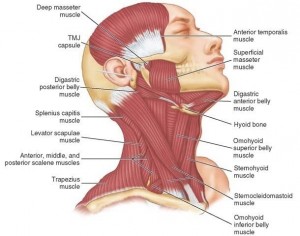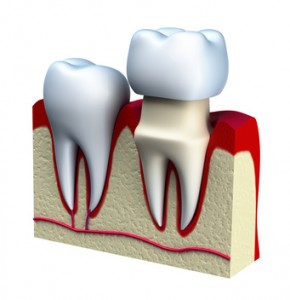TMJ Muscle Pain:
Myofascial Pain, Muscle Spasm & Muscle Splinting All Cause Pain!Muscle Stiffness, Soreness, or Pain?
 If you’ve been diagnosed with TMJ (Temporomandibular Joint Disorder) then you understand how this particular disorder can affect the overall quality of your life. It is obvious to anyone suffering from TMJ that the muscles are a major source of pain. When you’re in pain it’s hard to focus on anything else. If you’ve already seen your doctor and are still experiencing jaw soreness, stiffness or a tingling sensation then it might be time for you to explore other possibilities. Because the TMJ problems you’re experiencing are related to your jaw joint, a dental solution may be your best bet.
If you’ve been diagnosed with TMJ (Temporomandibular Joint Disorder) then you understand how this particular disorder can affect the overall quality of your life. It is obvious to anyone suffering from TMJ that the muscles are a major source of pain. When you’re in pain it’s hard to focus on anything else. If you’ve already seen your doctor and are still experiencing jaw soreness, stiffness or a tingling sensation then it might be time for you to explore other possibilities. Because the TMJ problems you’re experiencing are related to your jaw joint, a dental solution may be your best bet.
The biggest struggle that people have when diagnosed with TMJ is the pain and discomfort they often experience. Some people may experience minimal pain while others are needing some help because the pain is getting in the way of their being able to enjoy their everyday lives. Muscle spasms and stiffness, as well as back pain and neck pain are also experienced by those suffering from TMJ. If treatment is not sought in order to correct these symptoms, you’re more prone to experiencing Myofascial Pain (MPD), which often requires additional solutions. Myofascial Pain is characterized by taut muscle bands with Trigger Points that can cause referred pain, or pain that is experienced in sites other than where it is generated.
What’s important to understand here is that once you’ve been diagnosed with TMJ, it’s essential that you check out all of your viable options. One of these options is understanding that this could all be dental and/or bite related.
Do I have TMJ Disorder?
Symptoms include migraines, neck pain, jaw pain, lower back pain, snoring, sleep apnea. Use our Free TMJ Disorder Assessment ToolsA Bite Problem Could Affect Your Muscles and the Muscles Can Create a Bite Problem
There’s a very close connection between your teeth and the way you bite down that can directly affect the overall position of your jaw. If your jaw is not properly aligned, it can strain the muscles and nerves, which can cause you pain. Symptoms like stiffness, twitching, cramping and extreme tension can all be caused by jaw problems. The good news is that there’s help for you. Physiologic dental treatments could provide a solution that could work for you.
Muscle Splinting Is Actually A Protective Measure Your Body Uses To Protect A Site Of Injury
The muscles shorten and stiffen to spint an injury much as a physician puts a cast over an injury. In the short term muscle splinting decreases pain and protects the injury in a joint, bone or soft tissue. The problem is that long term splinting can create Myofascial Pain and Dysfunction Syndrome. A protective muscle response can create a new a primary problem. Treatment with Physiologic Dentistry and ULF-TENS allows the body to eliminate unnecessary muscle splitting.
Muscle Spasm is an Acute Problem
Muscle spasm is usually a short lived event in response to a specific trigger. Muscle spasm can evolve into Myofascial Pain or into Crhonic Myositis or muscle inflammation. There are usually underlying biochemical or metabolic issues when Chronic Myositis is experienced.
Now What?
The first step is to map the muscles and evaluate for Myofascial Pain, Muscle Splinting, Muscle Spasm or Myositis. Myositis may require a blood test called a Sed Rate to be diagnosed.
Direct TMJ Muscle Pain Treatments
- Spray and Stretch with Vapocoolant can give quick relief and can be utilized by the patient at home or at work
- Trigger Point injections can eliminate taut bands and trigger points
- Massage and Acupressure or Trigger Point manual therapy can eliminate muscle pain and restore function.
- Prolo therapy can heal soft tissues to eliminate muscle splinting and help myositis.
- Physical Therapy modalities
- Exercise
- Yoga
Phase Two Treatments
 Multiple treatment options are available that could remedy your TMJ symptoms once a diagnosis is established.
Multiple treatment options are available that could remedy your TMJ symptoms once a diagnosis is established.
Long Term physiologic orthotics can help to correct your bite, your jaw will move into the correct position and the stress and strain on your muscles will start to be relieved. Creating a healthy landing spot on the diagnostic orthotic allows physiological healing of the muscles.
A full mouth reconstruction is another, more permanent option. With the use of treatments such as dental veneers, implants, and crowns, your teeth can be reshaped and resized to correctly fit together, correcting your bite. Your jaw will then be in the correct position, relieving the tension in your neck, back, arms, and more.
Orthodontics can be utilized alone or in conjunction with restorative dentistry to create a healthy physiologic bite.
Surgery is an option that is usually best avoided.
The DNA Appliance utilizes Epigenetic Orthodontics and may be an excellent approach for many patients. The DNA Appliance grows bone orthopedically correcting the underlying problem.
Could Dental Treatments Relieve Your Muscle Tension?
A thorough evaluation would need to be done in order to determine the exact cause of your pain, and to evaluate whether your jaw and bite are indeed related. Once this is done, we can discuss what the best treatment option for you would be to help relieve your symptoms.


Francis Hartmann, Gerard CUCCHI. NEW DATA about TEETH CLENCHING and OUTCOMES Springer 300p, 250 Ill
I read the info on the book mentioned and agree that the Trigeminal Nervous System is in the center of these problems and cleNching secondary to stress ala Hans Selye in his book “THE STRESS OF LIFE” is a major issue. MANY ISSUES ARISE SECONDARILLY WHICH IS WHY TMJ DISORDERS ARE KNOWN AS “The Great Imposter.
I utilize Sphenopalatine Ganglion Blocks to turn off the Sympathetic overload caused by stress and to turn of “FIGHT OR FLIGHT” and to turn on PARASYMPATHETIC “FEED AND BREED” of the Autonomic nervous system.
I have printed up the information from your post and where it leads for anyone interested.
Stress and Orality
New Data About Teeth Clenching & Outcomes, Migraine, Fibromyalgia, Fatigue
Authors: Hartmann, Francis, Cucchi, Gérard
Approach results both from personal clinical observation about pain and dysfunctions of the oral sphere and international bibliographic fundamental study (especially in neurosciences)
see more benefits
About this book
About the authors
“The reading of STRESS and ORALITY written by F. HARTMANN and G. CUCCHI led me to believe that we should consider the problem of certain migraines, neck pain, fibromyalgia, and chronic fatigue from a radically different angle than the historically traditional approach.” Pr Roger Guillemin (Nobel Laureate in Medicine)
Are oral disorders only an issue for dentists? The answer is no.
If your patients complain of pain and/or discomfort, if some are diagnosed as suffering from migraines, fibromyalgia or chronic fatigue, and if classical therapies have remained ineffective, this book could help in your daily practice. When it comes to the complex pathology called Temporo-Mandibular Disorders (TMD) most specialists favour a multidisciplinary approach and treatment of socio-psycho-emotional factors as well as dental, lingual or postural disorders. Yet little is known – from a clinical point of view – about a tricky oral spastic habit called severe teeth clenching. In view of the lack of clinical findings from classical investigations on the subject, it could be considered as the “hidden part of an oral parafunctional iceberg”. Neuroscience has been able to shed some light on the multiple connections between trigeminal and non-trigeminal nervous centres, which confirms the significant involvement of the stomatognathic system and trigeminal nerves (V) in both oral as well as non-oral major functions such as eating, breathing, speaking, hearing, and standing … and also confirms the extensive participation of the paired Vs in the human adaptation process. Too many physicians are still reluctant to admit the pathological responsibilities of the Vs. Therefore their role remains largely underestimated by clinicians. Stress conditions in introverted people (I FIND THAT MANY TYPES OF PEOPLE NOT JUST THE INTROVERTEED ARE AFFECTED) cause a parafunctional habit (i.e. severe clenching), which in turn produces trigeminal overstimulation and nociception.( NOCICEPTION OR PAIN INPUT BASICALLY ACTS LIKE GARBAGETHROWN INTO THE SYSTEM) Through a process of sensitization this can perturb some non-trigeminal nervous areas, such as the vestibular nuclei and cerebellum (involved in equilibrium). Would you then be willing to accept the possibility that a stressed and introverted patient who clenches hard, durably or frequently may end up suffering from dizziness? (DIZZINESS CAN COME FROM HYPOTHALAMUS, DIRECT EFFECTS OF TMJOINT ON MIDDLE EAR STRUCTURES, SECONDARY TO TRIGEMINAL NERVES ENTERING INTO EAR FUNCTION THE EXAMPLE BEING TENSOR TYMPANNI INNERVATED BY TRIGEMINAL NERVE) If not, this book is not for you. But if you accept the scientific data and clinical facts this book will offer a concrete therapeutic protocol: the Relaxing and Moderating Treatment (RMT), which can greatly help you to familiarize yourself with and neutralize this little known deleterious spastic oral parafunction and its many disconcerting pain-causing and dysfunctional clinical effects. Prepare to be amazed by the results, just as we were!
I WOULD SUGGEST THIS IS PROBABLY WORTH THE READ AS IT WILL ENCOMPASS ISSUES THAT PATIENTS SUFFER BUT i CAUTION THE READER TO BE AWARE THAT MANY PATIENTS NOCICEPTION AND STRESS OVERLOAD IS DUE TO PHYSICAL FACTORS OTHER THAN CLENCHING. PLEASE VISIT MY YOUTUBE CHANNEL FOR PATIENT TESTIMONIALS. https://www.youtube.com/channel/UCk9Bfz6pklC7_UluWFHzLrg